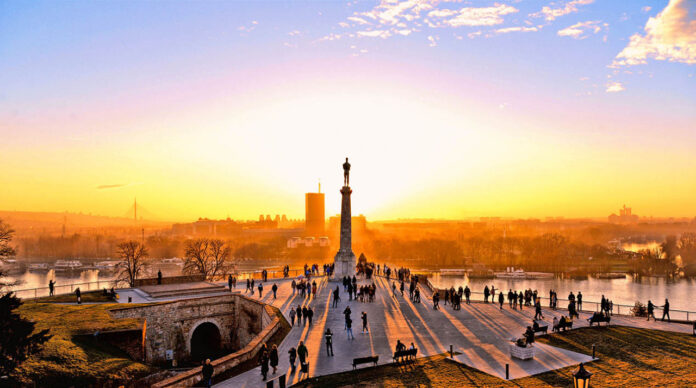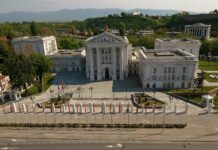When can we truly say that a city is big? Does this bigness reflect in the number of people living in it, perhaps its financial power, or the ideas that come from it? Maybe, however, the diversity of all kinds is the true criterion that defines this term.
If we were to empirically determine this adjective, we would have to consider various parameters. Belgrade, certainly populous (at least by Balkan standards) and, as some would say, the only “real” metropolis of former (and current) Yugoslavia, actually represents a kind of palette… of everything, something unique for the state of Serbia and the Balkans in general.
In this city, you can find the greatest contrasts of a country – extreme right-wingers, but also left-wingers, the cradle of religious fundamentalism, yet at the same time a city whose truly diverse art scene has produced Marina Abramović, perhaps the most renowned artist from this region ever.
Although today, for example, Sarajevo is considered the “Jerusalem of Europe,” we must not underestimate the religious (e.g., the number of Muslims alone equals the population of Brčko) and national diversity in Belgrade itself. And when you add newly arrived Russians, Chinese, and Cubans (the latter is even strange for the author of this text) to all of this, making the total population equivalent to the optimal size of Podgorica, you really get an extraordinary picture for these parts.
Financial parameters are also convincingly on Belgrade’s side; in a country with a faltering economy, where the standard is questionable and with never greater class differences, this city, although certainly not perfect, strives to keep its “head above water.” Thus, we can conclude that the average salary in Belgrade is 40% above the national level, and the number of investments is tenfold higher compared to any other city in the country.
So, although the slogans of the supporters say that “Kosovo is the heart of Serbia,” from all parameters, it can be concluded that it is Belgrade – not just the heart, but also the backbone and soul of this small country. Perhaps that’s why the announcement by the former mayor Aleksandar Šapić, if he loses power – “He will go out to fight on the streets.”
I don’t know how developed the martial arts skills of the former water polo player are, but I’m sure we wouldn’t see them in any case. Behind the harsh words and accusations lies fear, the genuine one, because according to the latest elections, the ruling SNS does not have a sufficient majority to form the government in the capital of Serbia on its own. The elections have passed, many coalitions and agreements have failed, and there is still no new mayor.
In Belgrade, there is a local term “Krug dvojke” often used pejoratively, which actually indicated the route of the tram passing through the very narrow center of the city. Today, this term, in fact a geographic one, is often used to name people whose views are somewhat more urban, intellectual, and as right-wingers would characterize them, “other Serbia” (equivalent – traitorous). The current government often negatively characterized the ideas of the most urban part, the most urban city in Serbia (no offense to the people of Novi Sad), citing them as opposed to what the “average citizen of Serbia” wants – whatever that means. You see, these elections have shown that these “different” ideas are not just within that “Krug dvojke”; the current, aforementioned former mayor lost power in all central municipalities. When you look at the map of results, you clearly see that the current government won only in suburban settlements, which until a few decades ago were not considered integral parts of Belgrade. Perhaps that’s why Aleksandar Šapić announced his “new” battle for Belgrade. However, Belgrade has seen many battles; official history says it has been razed to the ground 44 times (alongside Warsaw and Berlin, the most in Europe), so this “thug” rhetoric can be considered usual in the lives of those living here.
If we were to look at the history of this city, we would realize that despite being in a politically volatile environment, this city often demonstrates political disobedience. Whether it was against various kings, sultans, and pashas, even against Adolf Hitler and joining the Tripartite Pact (which were the first official rebellion against Nazism in the entire former Yugoslavia), all the way to the fall of Milošević. Somehow, it can be concluded that those “street fights” didn’t exactly favor the current systems; some would even say that the former mayor doesn’t know enough about the history of the city he led.
Belgrade is damaged, it has scars, but it plays the most beautiful music through the rhythm of trams (especially those “Krug dvojke”) and the steps of its citizens. And there are Belgraders, and there will be more of them, along with the aforementioned Novi Sad, it is the only city experiencing population growth. In short, Belgrade belongs to everyone, yet it manages to remain true to itself, and therein lays the greatness of this city. This is a place that, despite wars (both recent and past), has managed to preserve the idea that we are all – first and foremost – Belgraders, and a Belgrader is anyone who loves this city.
In the end, I would add only this; in the history of elections in Serbia, from the Principality until today, anyone who “captured” Belgrade later also “captured” Serbia; that germ of change has transformed this country, and often the region – may it be so this time as well.
As for Aleksandar Šapić himself, I would paraphrase a much more famous fellow citizen, Momčilo Kapora, who says: “Belgraders, otherwise brave people, fear only two things: ice in their drinks and drafts.” So, dear Aleksandarr (this time Šapić), in our city, our people, they are not afraid.
Written by: Darko Mandic













